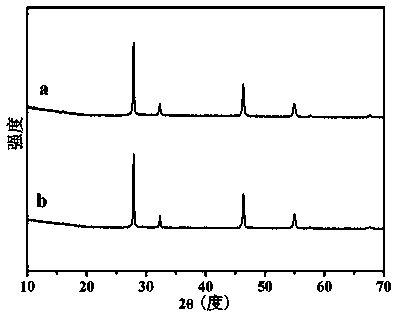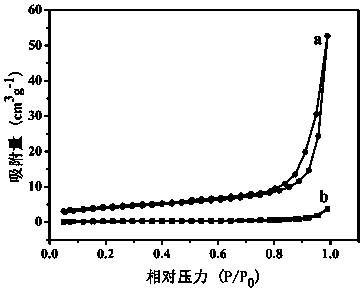Graphene-CuInS2 nano composite photocatalyst
A nano-composite, photocatalyst technology, applied in physical/chemical process catalysts, chemical instruments and methods, chemical/physical processes, etc., can solve problems such as harming the environment, expensive metal materials, easy dissolution, etc. Stability and regeneration performance, effect of large specific surface area
- Summary
- Abstract
- Description
- Claims
- Application Information
AI Technical Summary
Problems solved by technology
Method used
Image
Examples
Embodiment 1
[0031] (1) Using graphite powder as raw material, graphene oxide was synthesized by Hummers method, and then graphene oxide was dispersed into N,N-dimethylformamide solution.
[0032] (2) Add 1.0 mmol of cuprous chloride, 1.0 mmol of indium chloride, and 2.5 mmol of thioacetamide into 40 mL of N,N-dimethylformamide solution and stir until the solution is transparent, then add 0.00211 g of graphene, Then ultrasound was performed for 60 min.
[0033] (3) Transfer the solution to a 100 mL reactor, 120 o C, the reaction time is 8 hours.
[0034] (4) Centrifuge the reacted sample and wash it several times with deionized water and ethanol. o C for 12 hours under vacuum. Then take it out, let it cool naturally, and grind it. The obtained product is rGO-CuInS 2 Nanocomposite photocatalysts.
Embodiment 2
[0036] (1) Using graphite powder as raw material, graphene oxide was synthesized by the Hummers method, and then graphene oxide was dispersed in ethylene glycol solution.
[0037] (2) Add 1.0 mmol of cuprous chloride, 1.0 mmol of indium chloride, and 2.5 mmol of thioacetamide into 40 mL of ethylene glycol solution and stir until the solution is transparent, then add 0.00211 g of graphene, and then perform ultrasonication for 60 min .
[0038] (3) Transfer the solution to a 100 mL reactor, 120 o C, the reaction time is 8 hours.
[0039] (4) Centrifuge the reacted sample and wash it several times with deionized water and ethanol. o C for 12 hours under vacuum. Then take it out, let it cool naturally, and grind it. The obtained product is rGO-CuInS 2 Nanocomposite photocatalysts.
Embodiment 3
[0041] (1) Using graphite powder as raw material, graphene oxide was synthesized by Hummers method, and then graphene oxide was dispersed into ethanol solution.
[0042] (2) Add 1.0 mmol of cuprous chloride, 1.0 mmol of indium chloride, and 4 mmol of thioacetamide into 40 mL of ethanol solution and stir until the solution is transparent, then add 0.01055 g of graphene, and then perform ultrasonication for 60 min.
[0043] (3) Transfer the solution to a 100 mL reactor, 180 o C, the reaction time is 15 hours.
[0044] (4) Centrifuge the reacted sample and wash it several times with deionized water and ethanol. o C for 12 hours under vacuum. Then take it out, let it cool naturally, and grind it. The obtained product is rGO-CuInS 2 Nanocomposite photocatalysts.
PUM
| Property | Measurement | Unit |
|---|---|---|
| clearance rate | aaaaa | aaaaa |
Abstract
Description
Claims
Application Information
 Login to View More
Login to View More - R&D
- Intellectual Property
- Life Sciences
- Materials
- Tech Scout
- Unparalleled Data Quality
- Higher Quality Content
- 60% Fewer Hallucinations
Browse by: Latest US Patents, China's latest patents, Technical Efficacy Thesaurus, Application Domain, Technology Topic, Popular Technical Reports.
© 2025 PatSnap. All rights reserved.Legal|Privacy policy|Modern Slavery Act Transparency Statement|Sitemap|About US| Contact US: help@patsnap.com



